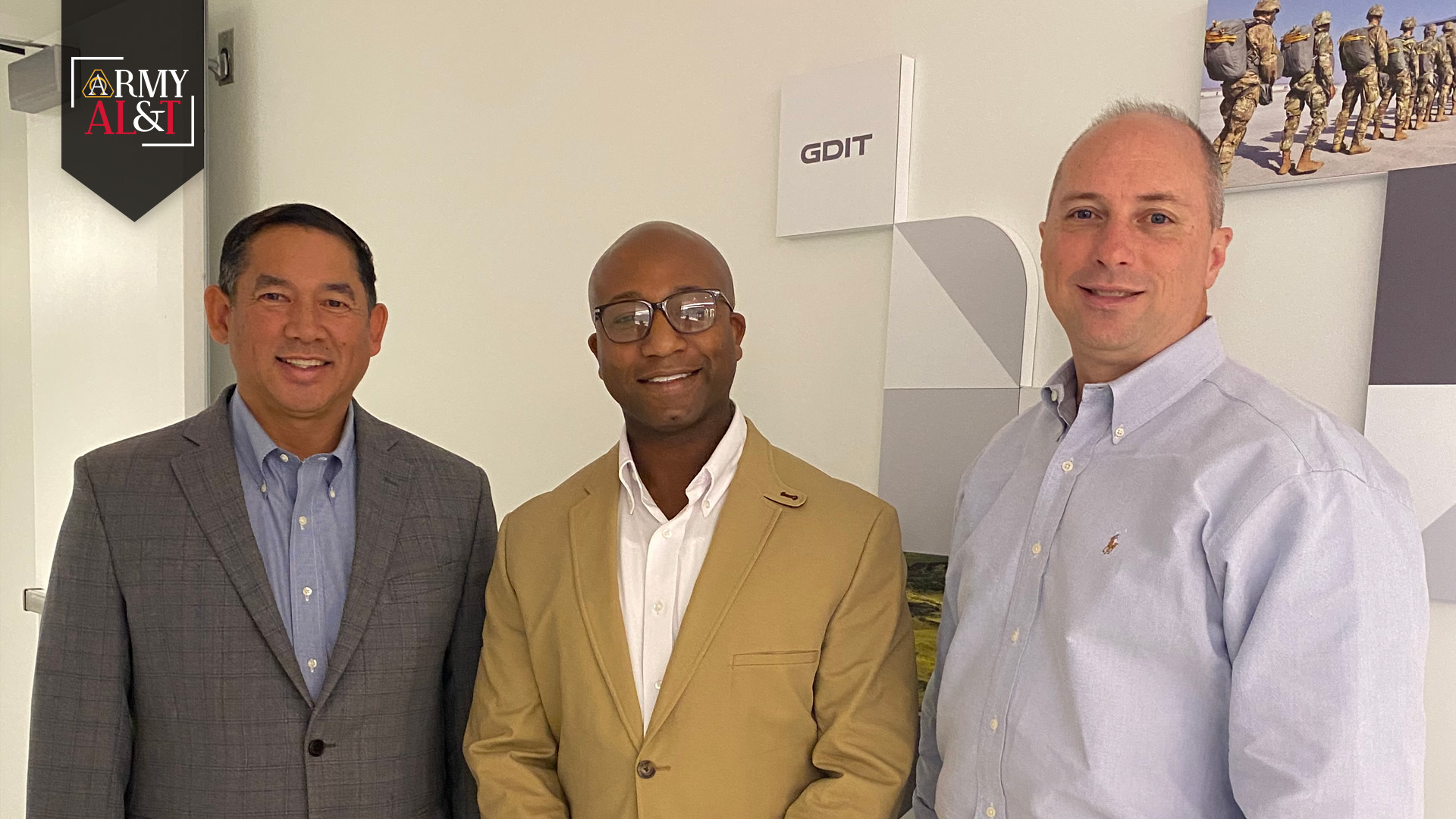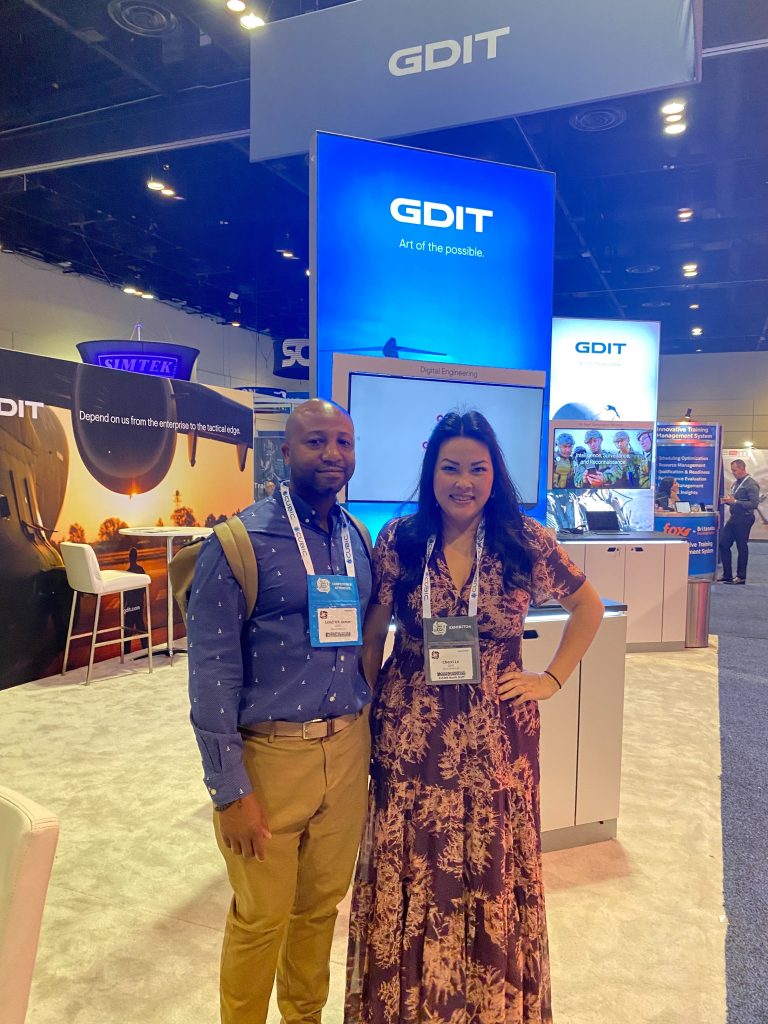
STRONG OBJECTIVES: From left, Maj. Gen. (Ret.) Garrett Yee, vice president and general manager at GDIT; James and Craig Whitten, met in Sept. 2022, in Falls Church. Yee and Whitten provided objectives for James to focus on and insight on ways the government and industry can work together to create stronger relationships.
Training With Industry program provides valuable opportunities for Soldiers.
by Lt. Col. Lendrick James
My role as a Training With Industry (TWI) fellow has been one of the most rewarding and interesting experiences I have had in the military.
TWI is a one-year assignment designed to expose military acquisition professionals to industry best practices, management techniques and organizational structures. During my fellowship, I gained on-site experience, training and industry knowledge not normally obtained through traditional military or civilian education. It also provided an opportunity to acquire unique business knowledge and technical skills.
TWI is a broadening program available for active-duty military officers. Upon selection, TWI fellows are assigned to a company that supports DOD. They each work with their companies to develop individual goals and objectives they would like to achieve during the program. Once the goals are selected, fellows then send their customized training plans to the Office of the Director of Acquisition Career Management (DACM) for review and approval. Some of my individual goals included understanding different contract types, including the advantages and disadvantages of certain contracts, understanding how contracts influence a company’s ability to respond to situations, understanding the company’s strategic outlook and opportunity selection, understanding the company’s program financial metrics and understanding employee relations. This program benefits the acquisition workforce because it allows active-duty acquisition officers to look at contract actions from the perspective of industry partners. This creates a deeper understanding of what motivates industry to support DOD in the best possible way.
KNOWLEDGE GAINED
I first learned about TWI from information published in Army AL&T magazine. From there, I watched videos on YouTube that showed other officers’ experiences with the program, and it seemed like a great opportunity to grow and develop. Additionally, one of my mentors completed TWI and encouraged me to apply. Prior to applying for TWI, I was assigned to the Program Executive Office for Simulation, Training and Instrumentation as an assistant program manager for the Games for Training program, within the Product Manager for Common Synthetic Environment. I currently serve as a military assistant assigned to the Office of the Under Secretary of Defense for Acquisition and Sustainment. My experience with TWI has already helped with our mission of delivering capability at the point of need through a defense acquisition system that is flexible, tailorable and enables speed.
When assignments were announced, I learned that I would be working with General Dynamics Information Technology (GDIT), which is a proud partner of the Army’s TWI program. The company provides information technology products and services, primarily to DOD and other national security organizations.
When I began my fellowship, I did not know what to expect, but my sponsor, Craig Whitten, the director of managed services and OCONUS (outside of the continental United States) support, provided a list of business development objectives for me to achieve. I used these objectives to create a dashboard to monitor my monthly progress. Each month, I updated and reviewed my dashboard of objectives to ensure I remained on track. My focus areas included contracting, subcontracting, growth and additional professional development opportunities.
During my rotation with GDIT’s Contract Division, I was able to attend weekly meetings and observe the team as they vetted questions that would be sent to the government in response to multiple requests for proposal, or RFPs. It was interesting to watch the team compare the government’s contract data requirement list to their statement of work. Based on the number of inaccuracies or discrepancies in the documents, the Contract Division would decide whether to bid on proposals. This technique helped GDIT reduce potential risk. During future assignments, my goal is to ensure that the government takes pride in ensuring the contract data requirements lists and the statements of work are accurate, so we won’t lose potential offerors.
Working with GDIT’s Defense Subcontracts Division was also rewarding. I shadowed Lance Smith, a subcontracts administrator, and he provided a course on GDIT’s process of executing nondisclosure agreements (NDAs) and teaming agreements (TAs). GDIT’s NDAs and TAs are used when there is a need to hold specific discussions about the company’s proprietary information, or what many companies call their “secret sauce.” Additionally, Smith allowed me to observe the execution of an ongoing NDA from start to finish. During this process, I learned that GDIT has standard NDAs and TAs that are distributed to subcontractors who would like to partner with the company. Although GDIT’s NDAs and TAs are standard, companies can request changes, which may or may not be approved by GDIT’s legal team. This benefits the government because it could provide insight into an offeror’s ability to perform potential work.
Despite these great insights, I believe my time with GDIT’s Growth Division was the most beneficial of all. The Growth Division provides services, solutions and outcomes to win bids, while simultaneously proving to customers that they can deliver with little to no risk. I worked with Joseph Bartasius, the defense growth business development director, and watched as he expanded GDIT’s business to generate additional profits. He shared many tactics, techniques and tools used to accomplish his mission. This was particularly interesting because several of GDIT’s growth functions and methodologies are similar to techniques I used while serving in U.S. Army Recruiting Command. These included performing intelligence and market analysis, lead generation, prospecting, interviewing and processing customers and targeting. The knowledge I gained was beneficial, and now I have a better understanding of how defense contractors study the needs of the DOD and analyze market trends to develop a strategic process that helps their organization grow.

SHARE AND GROW
James met Cherri Le, GDIT communications manager, at the company’s Interservice/Industry Training, Simulation and Education Conference (I/ITSEC) booth in Nov. 2022, in Orlando, Florida. I/ITSEC is the world’s largest modeling, simulation and training event. Organizations attend each year to learn about new resources, present exhibit displays and network with government and industry partners to create future business opportunities.
WIN-WIN EXPERIENCE
Throughout this experience, I was fortunate to receive mentorship from GDIT’s senior executives, develop strong relationships with GDIT’s employees, participate in employee resource groups, or ERGs, participate in industry day events, witness a government accountability test and share lessons learned with other TWI fellows. I believe my greatest contribution was showing up prepared with a positive attitude, and ready to learn. I assisted the company by meticulously documenting each activity and event in which I participated by creating executive summaries, storyboards and progress dashboards. This technique not only documented the events but also ensured that I understood what took place. This was a “win-win” for both GDIT and the Army because it helped ensure I learned GDIT’s best practices, while simultaneously providing quality products.
CONCLUSION
Based on my experience with the program, I believe TWI is appropriate for senior majors and lieutenant colonels. Working directly with industry gave me an opportunity to become a part of the company. When wearing a uniform and conducting business with industry, it is a much different experience. The company’s employees are working to create the best possible outcome for the company, and the acquisition officer is working to create the best possible outcome for the government. However, while serving as a fellow you become a company insider and everyone’s guards are lowered. You are no longer competing and serving different interests. This allows the company to reveal their strategic objectives and reasoning behind many of their processes. When officers have this deeper understanding and knowledge about industry strategies, it will greatly improve the defense acquisition system. This will also foster improved strategic forecasting and will allow them to play chess instead of checkers.
TWI is relevant to Army acquisition professionals. It gave me the ability to look at business processes and situations from both the government viewpoint and the industry viewpoint. Having completed the program, one of my new goals will be to help government employees understand proposals from the industry point of view. I am extremely grateful for this opportunity, and I look forward to applying what I’ve learned in future military assignments.
For more information about the TWI program, go to https://asc.army.mil/web/career-development/programs/aac-training-with-industry.
LT. COL. LENDRICK JAMES is a military assistant assigned to the Office of the Under Secretary of Defense for Acquisition and Sustainment. He holds an M.S. in management from Embry-Riddle Aeronautical University, an M.A. in general studies from the U.S. Army Command and General Staff College and a B.A. in political science from South Carolina State University. He holds the DAWIA Practitioner certification in program management.







